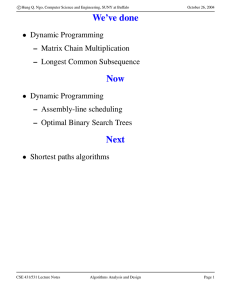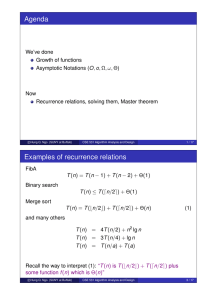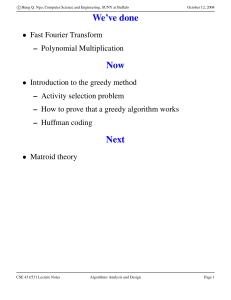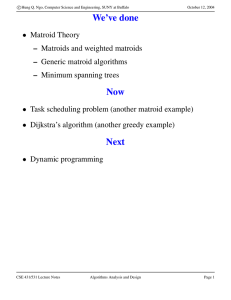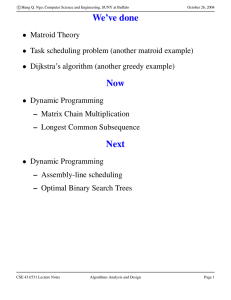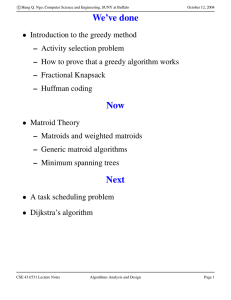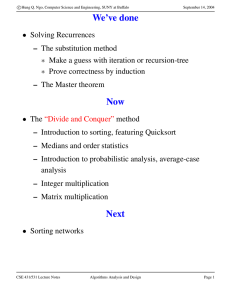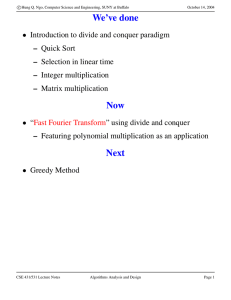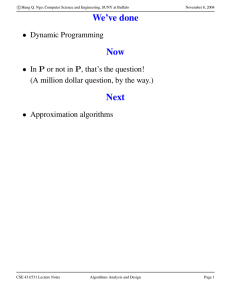Document 10791718
advertisement
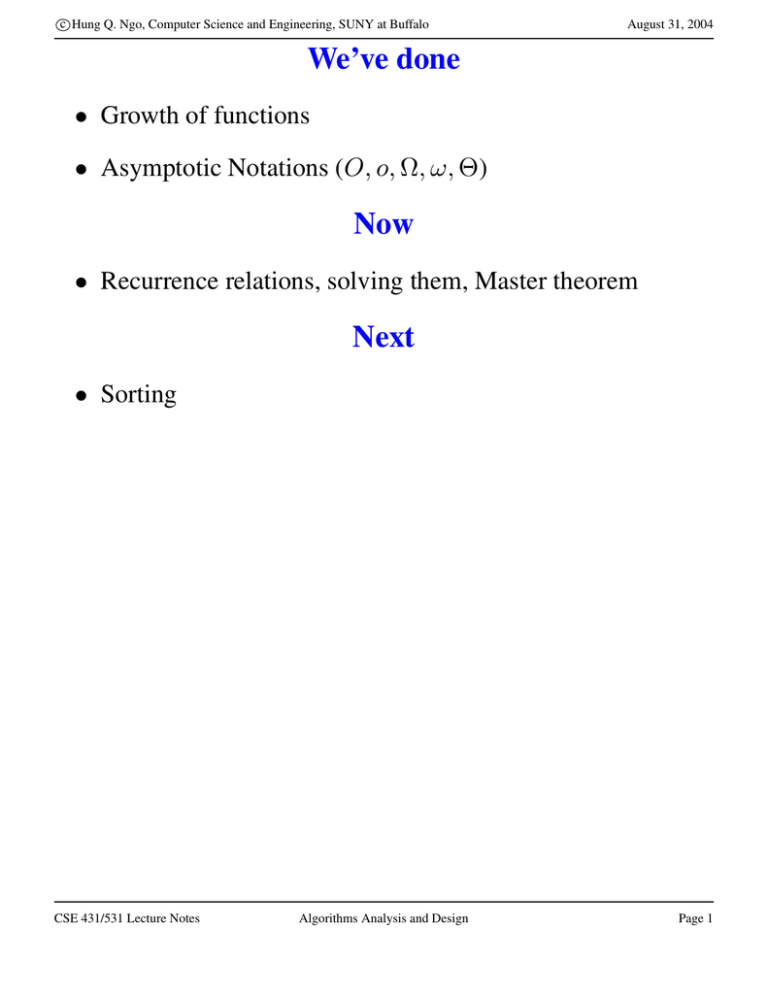
c Hung Q. Ngo, Computer Science and Engineering, SUNY at Buffalo August 31, 2004 We’ve done • Growth of functions • Asymptotic Notations (O, o, Ω, ω, Θ) Now • Recurrence relations, solving them, Master theorem Next • Sorting CSE 431/531 Lecture Notes Algorithms Analysis and Design Page 1 c Hung Q. Ngo, Computer Science and Engineering, SUNY at Buffalo August 31, 2004 Recurrence Relations: Examples FibA T (n) = T (n − 1) + T (n − 2) + Θ(1) Binary search T (n) ≤ T (dn/2e) + Θ(1) Merge sort T (n) = T (bn/2c) + T (dn/2e) + Θ(n) (1) and tons of others T (n) = 4T (n/2) + n2 lg n T (n) = 3T (n/4) + lg n T (n) = T (n/a) + T (a) As we’ve done earlier, equations like (1) means: “T (n) is T (bn/2c) + T (dn/2e) plus some function f (n) which is Θ(n)” CSE 431/531 Lecture Notes Algorithms Analysis and Design Page 2 c Hung Q. Ngo, Computer Science and Engineering, SUNY at Buffalo August 31, 2004 Recurrent Relations: Methods • Substitution method • Recurrence tree • Generating functions and others (take CSE 594 next sem) • Master Theorem CSE 431/531 Lecture Notes Algorithms Analysis and Design Page 3 c Hung Q. Ngo, Computer Science and Engineering, SUNY at Buffalo August 31, 2004 The Substitution Method Mostly to show O and Ω relations • Guess a solution • Use induction to show it works Recall the first lecture a T (n) = T (n − 1) + T (n − 2) + b if n ≤ 1 if n ≥ 2 then we “guess” T (n) = (a + b)Fn+1 − b (2) where Fn is the nth Fibonacci number √ !n √ !n 1− 5 1+ 5 1 1 −√ Fn = √ 2 2 5 5 √ !n ! 1+ 5 = Θ = Θ(φn ) 2 Hence (why?), T (n) = Θ(φn ) (3) We can show both (2) & (3) by induction. CSE 431/531 Lecture Notes Algorithms Analysis and Design Page 4 c Hung Q. Ngo, Computer Science and Engineering, SUNY at Buffalo August 31, 2004 More examples • Given T (1) = Θ(1) T (n) = T (bn/2c) + T (dn/2e) + Θ(n), which means T (1) = c0 T (n) ≥ T (bn/2c) + T (dn/2e) + c1 n T (n) ≤ T (bn/2c) + T (dn/2e) + c2 n • Guess: T (n) = Θ(n lg n). • Need to show by induction that there are a, b > 0 s.t. an lg n ≤ T (n) ≤ bn lg n. Now try • T (n) = T (bn/2c) + T (dn/2e) + 1. • Guess T (n) = Θ(n). CSE 431/531 Lecture Notes Algorithms Analysis and Design Page 5 c Hung Q. Ngo, Computer Science and Engineering, SUNY at Buffalo August 31, 2004 Misc. Notes 1. It is often safe to ignore integrality issues. For example: T (n) = T (bn/2c) + T (dn/2e) + n, can be solved by saying T (n) = 2T (n/2) + n which gives the exact same solution. 2. To see why integrality isn’t important, consider T (n) = 2T (bn/2c + 17) + n. It is still O(n lg n). (Induction) 3. Avoid doing T (n) ≤ 2cbn/2c + n ≤ cn + n = O(n) which is dead wrong!! CSE 431/531 Lecture Notes Algorithms Analysis and Design Page 6 c Hung Q. Ngo, Computer Science and Engineering, SUNY at Buffalo August 31, 2004 Change of variable Solve √ T (n) = 2T ( n) + 1 Let m = lg n, then T (2m ) = 2T (2m/2 ) + 1 Let S(m) = T (2m ), then S(m) = 2S(m/2) + 1 Hence, S(m) = O(m) Thus, T (n) = S(lg n) = O(lg n) CSE 431/531 Lecture Notes Algorithms Analysis and Design Page 7 c Hung Q. Ngo, Computer Science and Engineering, SUNY at Buffalo August 31, 2004 How to guess? Iterating the recurrence a few times Like we did with the Fibonacci case. Use recursion-tree method Let’s try T (n) = 3T (bn/4c) + Θ(n2 ). Recursion tree suggests T (n) = O(n2 ). Now rigorously shows it by induction. Sick of induction already? Now try T (n) = T (n/3) + T (2n/3) + O(n) CSE 431/531 Lecture Notes Algorithms Analysis and Design Page 8 c Hung Q. Ngo, Computer Science and Engineering, SUNY at Buffalo August 31, 2004 Master Theorem Let a ≥ 1, b > 1 be constants. Suppose T (n) = aT (n/b) + f (n), where n/b could either be dn/be or bn/bc. Then 1. If f (n) = O(nlogb a− ) for some > 0, then T (n) = Θ(nlogb a ) 2. If f (n) = Θ(nlogb a ), then T (n) = Θ(nlogb a lg n) 3. If f (n) = Ω(nlogb a+ ) for some > 0, and if af (n/b) ≤ cf (n) for some constant c < 1 for all sufficiently large n, then T (n) = Θ(f (n)) CSE 431/531 Lecture Notes Algorithms Analysis and Design Page 9 c Hung Q. Ngo, Computer Science and Engineering, SUNY at Buffalo August 31, 2004 Examples • T (n) = 8T (n/2) + n5 • T (n) = 8T (n/2) + n4 • T (n) = 8T (n/2) + n3 • T (n) = 3T (n/2) + n2 • T (n) = 3T (n/2) + n Notes • There is a gap between case 1 & case 2 • There is a gap between case 2 & case 3 • There is a gap within case 3 CSE 431/531 Lecture Notes Algorithms Analysis and Design Page 10




